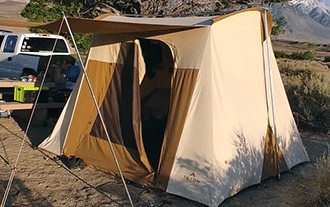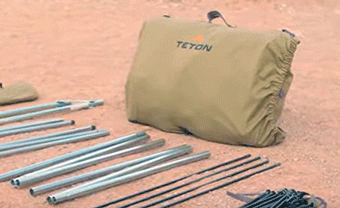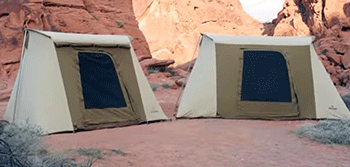If you’re looking for a tent that combines durability, comfort, and ease of use, the Teton Mesa Tent is a game-changer. As someone who’s spent countless nights under the stars, I can confidently say this tent has redefined my camping experience. Whether you’re a seasoned camper or a newbie looking for a reliable shelter, the Teton Mesa Tent is worth every penny. In this review, I’ll walk you through my personal experience, its pros and cons, maintenance tips, and how it stacks up against other brands. Trust me, by the end of this, you’ll be ready to hit “add to cart.”
My Experience With The Teton Mesa Tent
Let me start by saying this: the Teton Mesa Tent is a beast. From the moment I unboxed it, I could tell this wasn’t your average tent. The heavy-duty canvas, sturdy steel poles, and robust carrying bags screamed quality. Here’s what stood out during my first camping trip:

- Easy Setup: I was skeptical about setting up a canvas tent, but the Teton Mesa surprised me. The push-down top bar and straightforward pole system made it a breeze. Even as a solo camper, I had it up in under 30 minutes.
- Weatherproof Performance: During a sudden downpour, I braced myself for leaks, but not a single drop made it inside. The waterproof canvas and reinforced seams held up like a champ.
- Spacious Interior: The 10×14 size comfortably fit my queen-sized air mattress, camping gear, and still had room to spare. The extra-high ceilings made it feel like a home away from home.
- Ventilation: The mesh screens and large awning provided excellent airflow, even on warmer nights. No stuffiness here!
- Durability: The carbon steel stakes drove effortlessly into rocky terrain, and the heavy-duty zippers felt like they could withstand years of use.
This tent isn’t just functional—it’s built to last.
Pros Of The Teton Mesa Tent
Let’s dive deeper into what makes this tent a standout choice:
Also Read: My Thought on Why You Should Buy The Pogo Bounce House
- Heavy-Duty Construction: The canvas material and steel poles are built to withstand harsh weather conditions. It’s not just a tent; it’s a fortress.
- All-Season Protection: Whether it’s rain, wind, or sun, this tent has you covered. The breathable canvas ensures comfort in any season.
- Roomy Design: With extra-high ceilings and oversized doors, moving gear in and out is a breeze. It’s perfect for families or groups.
- Easy Setup: The intuitive design means you’ll spend less time setting up and more time enjoying the outdoors.
- Ventilation and Views: The mesh screens and large awning offer excellent airflow and scenic views, making it feel less like camping and more like glamping.
- Durable Accessories: From the extreme stakes to the heavy-duty carrying bags, every component is designed to last.
- Power Access Ports: Running power into the tent is seamless, making it ideal for extended stays or backyard camping.
- Organizational Features: The loft and pocket organizers keep your gear tidy, so you’re not tripping over clutter.
Cons Of The Teton Mesa Tent
No product is perfect, and the Teton Mesa Tent has a few drawbacks worth noting:

- Weight: This tent is heavy. While the durability is a plus, it’s not the best option for backpacking or long hikes.
- Price: It’s an investment. If you’re a casual camper, the cost might feel steep compared to cheaper nylon tents.
- Setup Time: While easier than most canvas tents, it still takes longer to set up than pop-up tents.
- Footprint Sold Separately: You’ll need to purchase the footprint separately for added ground protection, which feels like an unnecessary extra cost.
- Seasoning Required: Like all canvas tents, it needs to be seasoned (waterproofed) before use, which can be a hassle for first-time users.
- Bulky Storage: The tent and its components take up a lot of space, so storage can be tricky if you’re short on room.
- Limited Portability: Due to its size and weight, it’s not the most portable option for frequent travelers.
- Learning Curve: If you’re used to nylon tents, the setup and maintenance of a canvas tent might feel intimidating at first.
Maintenance Tips: How To Get The Most Out Of Your Teton Mesa Tent
To ensure your Teton Mesa Tent lasts for years, follow these maintenance tips:
- Season the Tent: Before your first use, season the canvas by wetting it and letting it dry completely. This tightens the fibers and enhances waterproofing.
- Clean After Use: Always clean the tent after each trip. Use a soft brush and mild soap to remove dirt and debris.
- Dry Thoroughly: Never pack the tent away wet. Mold and mildew can ruin the canvas. Let it air dry completely before storing.
- Store Properly: Keep the tent in a cool, dry place. Avoid storing it in direct sunlight or damp areas.
- Inspect Regularly: Check for tears, loose seams, or rust on stakes. Address any issues immediately to prevent further damage.
- Use a Footprint: Protect the tent floor by using a footprint. It adds an extra layer of durability and prevents wear and tear.
- Avoid Sharp Objects: Be mindful of sharp objects inside the tent, as they can puncture the canvas.
- Re-Waterproof Annually: Reapply a waterproofing treatment once a year to maintain the tent’s weather resistance.
Teton Mesa Tent Vs. Other Brands
How does the Teton Mesa Tent compare to other popular brands? Let’s break it down:
Teton Mesa Tent vs. White Duck Canvas Tents
- Durability: Both are heavy-duty, but the Teton Mesa’s steel poles give it an edge in stability.
- Setup: Teton Mesa is easier to set up, thanks to its push-down top bar system.
- Price: White Duck tents are often more expensive, making Teton Mesa a better value for budget-conscious campers.
- Ventilation: Teton Mesa’s mesh screens and awning provide superior airflow compared to White Duck’s designs.
Teton Mesa Tent vs. Nylon Tents
- Weather Resistance: Canvas outperforms nylon in extreme weather, making Teton Mesa the better choice for all-season camping.
- Durability: Nylon tents are lighter but less durable. Teton Mesa’s canvas construction ensures longevity.
- Comfort: Canvas tents like Teton Mesa offer better insulation and breathability, making them more comfortable for extended stays.
- Portability: Nylon tents win in this category, as they’re lighter and easier to carry.
Teton Mesa Tent vs. Bell Tents
- Space: Bell tents are round, which can limit interior layout options. Teton Mesa’s rectangular design maximizes usable space.
- Setup: Teton Mesa is quicker to set up, while bell tents often require more time and effort.
- Ventilation: Both offer excellent airflow, but Teton Mesa’s mesh screens provide better views and bug protection.
- Price: Bell tents are generally more expensive, making Teton Mesa a more affordable alternative.
More Comparisons: Teton Mesa Tent Vs. The Competition
Teton Mesa Tent vs. Kodiak Canvas Tents

- Setup: Kodiak tents are known for their ease of setup, but the Teton Mesa’s push-down top bar system gives it a slight edge in simplicity.
- Ventilation: Both tents offer excellent airflow, but Teton Mesa’s mesh screens and awning provide better views and bug protection.
- Price: Kodiak tents are often more expensive, making Teton Mesa a more budget-friendly option without compromising quality.
- Durability: Both are built to last, but Teton Mesa’s carbon steel stakes and heavy-duty zippers feel more robust.
Teton Mesa Tent vs. Coleman Nylon Tents
- Weather Resistance: Coleman tents are great for fair weather, but they can’t compete with Teton Mesa’s all-season durability.
- Comfort: Canvas tents like Teton Mesa offer better insulation and breathability, making them more comfortable for longer trips.
- Portability: Coleman tents are lighter and more compact, but they lack the durability and spaciousness of Teton Mesa.
- Longevity: While Coleman tents are affordable, they often need replacing after a few seasons. Teton Mesa is built to last for years.
Teton Mesa Tent vs. Springbar Canvas Tents
- Design: Springbar tents have a classic, retro design, while Teton Mesa offers a more modern aesthetic.
- Ease of Setup: Teton Mesa’s setup is quicker and more intuitive, especially for first-time users.
- Price: Springbar tents are significantly more expensive, making Teton Mesa a more accessible option for most campers.
- Features: Teton Mesa’s power access ports and organizational pockets add functionality that Springbar tents lack.
Also Read: My Thought on Why You Should Buy The Pogo Bounce House
Frequently Asked Questions (Faq)
White Duck tents are proudly made in the USA. They’re known for their high-quality craftsmanship and durable materials, making them a popular choice among campers.
It depends on your needs. Bell tents are great for their spacious, circular design and aesthetic appeal, but they can be harder to set up and less versatile than rectangular tents like the Teton Mesa. If you prioritize ease of use and functionality, a traditional tent might be a better fit.
Absolutely! Canvas tents, like the Teton Mesa, are known for their durability and longevity. With proper care, they can last for decades, unlike nylon tents, which often wear out after a few seasons.
Final Thoughts: Is The Teton Mesa Tent Worth It?
After spending several camping trips with the Teton Mesa Tent, I can confidently say it’s one of the best investments I’ve made for my outdoor adventures. Its heavy-duty construction, spacious design, and weatherproof performance make it a reliable shelter for all seasons. While it’s not the lightest or cheapest option on the market, the quality and features justify the price.
If you’re looking for a tent that combines durability, comfort, and ease of use, the Teton Mesa Tent is a no-brainer. Whether you’re camping with family, hosting a backyard glamping session, or braving the elements on a solo adventure, this tent has you covered—literally.
So, what are you waiting for? Grab your Teton Mesa Tent, pack your gear, and get ready to create unforgettable memories in the great outdoors. Trust me, you won’t regret it.
